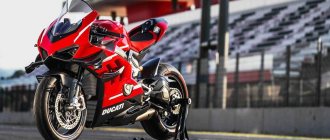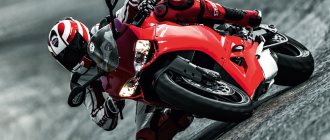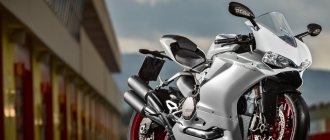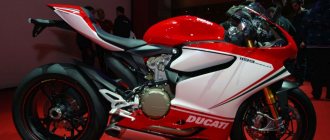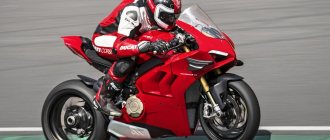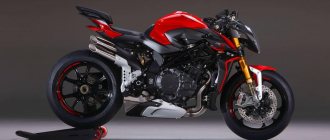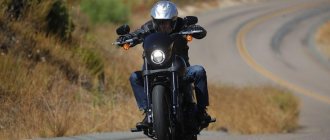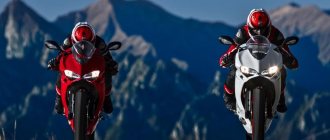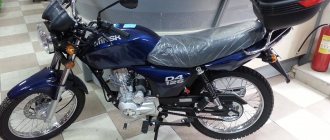Ducati Panigale V2 2020
For the last couple of years, the motorcycle community has been absolutely delighted with the Ducati Panigale V4. For Ducati, moving away from a V-twin on a flagship sportbike was a very atypical decision, but quite understandable, taking into account all the advantages of the Panigale V4 and V4R engine. However, somewhat lost in the shine of the Ducati V4 is the modest 959 Panigale - a very good machine that serves as a living reminder that Ducati has not yet parted with V-twins. It’s funny to consider an almost liter red sportbike “younger”, considering that with its 955 cubic meters it has more volume than the legendary flagship of the past - the 916. And yet, the Bologna-based company is taking its 959, sprucing it up in a number of ways, except one - the 955cc Superquadro V-twin, giving it a new name and releasing it for the 2021 model year. The engine remains the same, except that its exhaust emissions are now Euro5 compliant, thanks largely to a new design of the catalytic converter and exhaust system, which is snugly hidden under the bike and exits right next to the rear tyre. And this is already good news, because fans of Italian motorcycles probably remember that the previous 959 Panigale was equipped with a monstrous dual exhaust that disfigured a beautiful motorcycle.
Ducati Panigale V2 2021
The changes to the Ducati Panigale V2 do not only affect the exhaust gases: fresh air now reaches the engine more easily thanks to a new body kit that is closer to the silhouette of the Panigale V4. The new air intakes have a different shape, providing less pressure loss and a more constant air flow into the filter. In the combustion chambers, air is mixed with gasoline supplied through two injectors per cylinder, providing improved fuel reduction. The result is an increase in power of 5 hp. - up to 155 horses, and torque by 2 Nm, up to 104 Nm of total thrust, of which more than 60% is available at speeds above 5500. In addition, the new product received a one-sided swingarm in the style of the older Panigale.
Ducati Panigale V2 2020
The design is a significant, but not the most important, update to the Panigale V2. For the 2021 model year, Ducati will equip the V2 with the same suite of electronics as its big brother, the V4. The kit is based on a 6-axis inertia measurement device from Bosch and offers the following features:
- Tilt ABS EVO - with three operating options: 1 - In this mode, the rear ABS is disabled, the rear wheel lift-off control (anti-stop) and tilt angle tracking when the front ABS circuit is operating is disabled. This mode is ideal for racers. 2 - The mode allows a slide when braking, and it also disables the rear wheel lift-off control. 3 - In this mode, all safety systems for driving on roads and in poor grip conditions operate.
- Ducati Traction Control EVO2 - now with algorithms based on the GP18, V4R and V4R World Superbike MotoGP bikes, meaning the system operates in predictive mode, intervening earlier, faster and smoother than in reactive mode.
- Ducati Wheelie Control EVO - wheelie control that limits traction to prevent the front wheel from lifting off during sudden throttle opening
- Ducati Quick Shift up/down EVO2 - bi-directional quickshifter
- Engine Brake Control EVO - limits engine braking to prevent rear wheel stall during sudden throttle release and downshifting.
All these functions are configured using buttons on the remote controls, and the settings are displayed on a convenient 4.3-inch TFT display, again similar to that found on the V4.
And finally, the name is Panigale V2. Unpretentious, but let's think: why did they even call this model that way? It didn't just replace the 959 Panigale, it unified the Panigale line with a consistent naming convention, and I personally think it's Ducati's way of punching those armchair pundits who call Ducati V-twins L-twins because of their 90-degree camber angle. Probably, if Ducati even calls it V2, then it’s time to stop this debate.
The rest of the hardware of the Ducati Panigale V2 is quite in the spirit of the times: the 43rd Showa BPF fork, the Sachs rear monoshock absorber is 2 mm longer than the previous version, making the rear of the motorcycle 5 mm higher, taking into account the suspension arm and the pendulum axis. Brembo M4.32 calipers sit on 320 discs, and the Brembo radial master cylinder is equipped with an 18mm piston. Finally, the new seat is softer with an additional 5mm of thickness, and the added 20mm of length makes the seating experience more comfortable.
Ducati 1299 Panigale R Final Edition: tribute to the V2 plus MotoGP technology
The final chord in the history of the super sports V2 of Ducati, the most successful brand in the history of World Superbike, is the latest generation of the Ducati 1299 Panigale R Final Edition: this will complete the development of the project, but customers will be able to enjoy the unique sound of the V-Twin for several more years.
MOTOGONKI.RU, July 9, 2021 - In the fall of 2021, the Ducati holding will present a completely new platform for motorsports - the Ducati V4, born in the MotoGP racing department, not WorldSBK. This motorcycle will become the flagship for racing. V2 fans will be able to enjoy the Panigale and Panigale R for a few more years (at least 3 years).
Presentation of the Ducati 1299 Panigale R Final Edition in Laguna Seca
The presentation of the Ducati 1299 Panigale R Final Edition took place immediately before the start of the WSBK weekend in Laguna Seca, two bikes in the traditional Italian tricolor of the First Republic were rolled out onto the stage. The participation of Chaz Davis and Marco Melandri in the 8th round of the World Championship race on the 1199 Panigale R, painted in exactly the same colors, is a great marketing move: the bike will be remembered for a long time, especially considering that Davis took victory in Saturday's race!
Ducati 1299 Panigale R Final Edition
But the 1299 Final Edition will be remembered for another reason: it is the most technology-packed bike in the Ducati line-up. It's essentially a fully road-ready 1299 Superleggera, with the same 209 hp engine. at 11,000 rpm with an incredible torque of 142 Nm at 9,000 rpm. The engine is equipped with a lightweight crankshaft with an enlarged connecting rod journal and tungsten balancing spacers.
Ducati 1299 Panigale R Final Edition
The intake and exhaust valves are made of titanium, and the 116 mm pistons have a special 2-section design, like those found on World Superbike engines. The dry weight of the motorcycle is only 179 kg (this means the weight with battery and oil, but without gasoline). The engine for the Superleggera and Final Edition was developed by Ducati Corse, incorporating all the latest developments from the racing department, including those from MotoGP and World Superbike.
Ducati 1299 Panigale R Final Edition
Ducati 1299 Panigale R Final Edition - WSBK specification Ohlins suspension as standard
The base suspension is Öhlins, the fork rake is reduced to 24° to improve the responsiveness and steering of the motorcycle. The exhaust system for the Final Edition was specially developed by Akrapovič specialists: the same titanium system is installed here as on the Panigale R in World Superbike, but meets all Euro 4 requirements.
Ducati 1299 Panigale R Final Edition: electronics from World Superbike
The electronic components of the 1299 Panigale R Final Edition are the best that can be put on a superbike: the Bosch Inertial Measurement Unit (IMU) inertial platform is connected into a single network with proprietary Cornering ABS, which controls braking even in the most severe inclination; from the MotoGP arsenal, the Ducati Wheelie Control EVO (DWC EVO), Ducati Traction Control EVO (DTC EVO) and Engine Brake Control (EBC) systems are used here. All systems are connected and regulated by a single control unit, which has three preset operating modes: Race, Sport and Wet, but each can also be configured individually.
Ducati 1299 Panigale R Final Edition
Electronics from MotoGP
The 1299 Panigale R Final Edition is equipped with the full range of electronics as in WSBK and MotoGP and is based on the Bosch IMU inertial platform, as well as a DDA system with integrated GPS and a demonstration of the motorcycle's cornering angle.
Ducati Traction Control EVO (DTC EVO)
: The latest version of Ducati Corse's proprietary traction control in WSBK, linked to ABS and IMU. Analyzes the speed, lean angle of the motorcycle and accurately calculates the level of DTC involvement when the wheel begins to slip. Has several sensitivity levels. Interacts with the engine through adjusting the opening angle of the throttle valves, injector and ignition.
Ducati Wheelie Control EVO (DWC EVO)
— a system from MotoGP that controls the overhang of the front wheel during acceleration. Cleaner than the 2016 version.
Engine Brake Control (EBC)
- a system from MotoGP, also used in World Superbike: it controls engine braking and helps with emergency deceleration in difficult weather conditions. Reads the throttle opening angle and measures the load on the suspension.
Ducati Quick Shift (DQS)
- two-way quickshifter with direct connection to the slipper clutch and EBC.
Does the video take a long time to load? Click here!
Technical specifications of the 1299 Panigale R Final Edition
Engine:
V2 Superquadro with 2-segment pistons and increased compression
Additionally:
lightweight crankshaft, enlarged connecting rod journals, tungsten balance spacers, titanium valves with increased diameters of 48 (in) and 39.5 (exh) mm
Displacement:
1285 cc.
Dimensions:
116×60.8 mm
Power:
209 hp
at 11000 rpm. Torque:
142 Nm at 9000 rpm.
Clutch:
servo-assisted slipper in an aluminum basket
Transmission:
Manual, 6-speed
Electronics:
Bosch Inertial Measurement Unit (IMU), DWC EVO, EBC, DQS (two-way quickshifter)
Ducati Safety Pack:
Cornering ABS and DTC EVO (sport traction) control)
Riding modes:
Race, Sport, Wet
Information collection system (data logger):
DDA+ GPS with tilt angle demonstration
Intake system:
high-flow air filter
Exhaust system:
titanium Akrapovič 2-in-2 with placement under the seat
Compliance:
EURO 4
batteries:
Li-Ion
Ducati 1299 Panigale R Final Edition: Akrapovic titanium 2-into-2 exhaust system
Chassis:
Frame
- aluminum monocoque, combining a supporting structure and an air intake;
engine as load-bearing part of the chassis Suspensions:
Öhlins NIX30 43 mm fork, TTX36 rear shock
Forged aluminum
wheels Brakes:
Brembo M50 monoblock with 30 mm pistons, 330 mm discs
Base weight:
179 kg
Gross curb weight:
190 kg
Color:
tricolor (red-white-green) with red rims
Driving impressions
I think this is already clear, but I’ll say it anyway: the Ducati Panigale V2 is very good at going fast. And the famous track, with its mix of fast and slow corners and long straights, was perfect for testing all aspects of this bike. When I said that the “baby” can go fast, I didn’t mean how it reacts to the gas, but how smartly its traction is controlled. In the age of 200-horsepower sports cars, “only” 155 horses is a calming figure that allows you to relax and concentrate on more precise shifting, braking and steering.
Indeed, power without handling is nothing, and here Ducati is at its best. The traction control is smooth and linear, with excellent connection between the right wrist and the rear tire. And if your wrist asks for more than the splint can handle, the new V2 electronics step in and make things easier (but remember: it doesn't make you invulnerable!). The traction control, supported by an inertia measurement device, performs excellently in the Sport driving mode. All 155 horses are available in it, but they are slightly less aggressive than in Race mode. Traction control is set to 4 (medium) - it is felt, but not irritating. On other bikes, at full throttle, older versions of traction control make the bike buck and jerk like a half-wild mustang, and the DTC EVO2 fitted to the Panigale V2 significantly reduces jerk and minimizes intervention while everything is running as it should.
Switch the mode to Racing and you get the most direct connection between the throttle and the throttle, and the levels of traction control and C-ABS drop to 2. And here I still did not feel whether the electronics intervened, preventing the rear Pirelli Diablo Supercorsa SC2 from stalling (in stock V2 is shod in Diablo Rosso Corsa II). Same for the brakes: I still couldn't figure out if the C-ABS kicked in when I aggressively trail-braked. Speaking of brakes, the Brembos on this sportbike work quite well, they are powerful and responsive, but I would have preferred more initial grip and more active braking.
Cons of the Ducati Panigale V2 2020
Oh, and while we're on the subject of downsides: the quickshifter limits downshift speed to protect the engine from over-torque. In practice, this means that I cannot quickly drop three gears down in a row before a sharp turn, but am forced to slowly click one down three times in a row, alternating shifts with braking. Of course, I could shift the old fashioned way with the clutch, but you quickly get used to the quickshifter. And one more thing: the extra length of the seat is very good, but I wish Ducati would make it even longer, since with a tall person you sometimes sit on the passenger step.
Pros of the Ducati Panigale V2 2020
And now back to the positives, and specifically to steering. I'm not usually a fan of the monocoque (and that's fair enough when it comes to the past Panigale 1199 and 1299), but the V2's comparatively soft character suits its chassis well. It doesn't overload, allowing the bike to dive into corners easily when trail breaking and remain stable when leaning. It lacks that sharp front wheel feedback found on Ducati's cage-frame bikes, but the V2 is still pretty darn good. He is neutral in everything, so much so that his controllability remains in the shadows, as if you don’t notice it, because he simply does what you want. And this is good.
